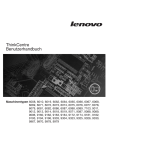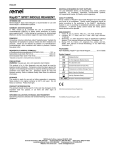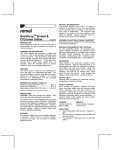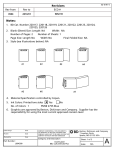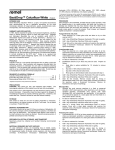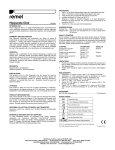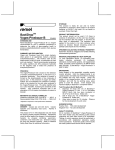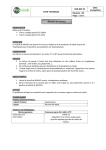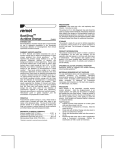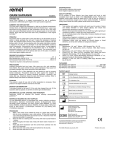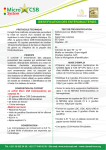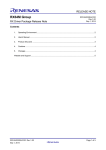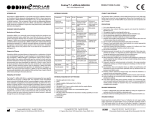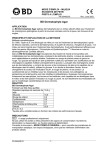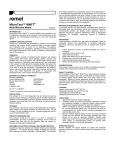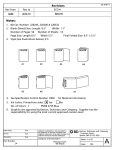Download BactiDrop Spot Indole (English)
Transcript
(3) the expiration date has passed, or (4) there are other signs of deterioration. The expiration date applies to the product in its intact container when stored as directed. Discard remaining portion of partially used ampule at end of workday. BactiDropTM Spot Indole (English) INTENDED USE TM Spot Indole is a reagent Remel BactiDrop recommended for use in qualitative procedures to determine the ability of an organism to split indole from the tryptophan molecule. SUMMARY AND EXPLANATION In 1969, Lowrance, Reich and Traub found ρ-Dimethylaminocinnamaldehyde (DMACA) to be the most sensitive indole reagent, capable of detecting 1 3 µg of indole per milliliter of medium. Vracko and Sherris, 1963, utilized indole-spot reagent for the presumptive separation of the Proteus sp. and 2 Escherichia coli. Ρ-Dimethylaminocinnamaldehyde is also used with anaerobes. PRINCIPLE Intracellular enzymes, collectively called “tryptophanase”, mediate the production of indole by hydrolytic activity against the amino acid tryptophan. Indole combines with DMACA to form a blue-green compound. The reaction occurs by a condensation process formed 3 by an acid splitting of the protein. SPECIMEN COLLECTION, STORAGE, TRANSPORT Specimens should be collected and handled following 4,5 recommended guidelines. MATERIALS REQUIRED BUT NOT SUPPLIED (1) Loop sterilization device, (2) Inoculating loop, swabs, collection containers, (3) Incubators, alternative environmental systems, (4) Supplemental media, (5) Quality control organisms, (6) Whatman filter paper (No. 1), or equivalent. PROCEDURE Place dropper in the assembled, reusable ampule crusher provided. Hold the dropper/crusher in an upright position and lightly tap the bottom to dislodge any bubbles that may have formed. Grasp the middle of the dropper/crusher with the thumb and forefinger, and with the tip pointing away, press gently to crush the ampule. Invert dropper and squeeze slightly to dispense in a dropwise fashion. Filter Paper Method: TM 1. Dispense 1-2 drops of BactiDrop Spot Indole onto a piece of No. 1 Whatman filter paper (or equivalent). REAGENTS (CLASSICAL FORMULA)* ρ-Dimethylaminocinnamaldehyde (CAS 6203-18-5)............................................. 10.0 g Hydrochloric Acid, Conc (CAS 7647-01-0) ... 100.0 ml Demineralized Water (CAS 7732-18-5) ........ 900.0 ml 2. Smear the growth from an actively growing pure culture onto the saturated filter paper. 3. Observe for the development of a blue color within 1-3 minutes. *Adjusted as required to meet performance standards. Swab Method: TM 1. Dispense 1-2 drops of BactiDrop Spot Indole onto the tip of a cotton swab. PRECAUTIONS WARNING! Causes eye, skin, and respiratory tract irritation. Corrosive to metal. This product is For In Vitro Diagnostic Use and should be used by properly trained individuals. Precautions should be taken against the dangers of microbiological hazards by properly sterilizing specimens, containers and media after use. Directions should be read and followed carefully. Refer to Material Safety Data Sheet for additional information. STORAGE This product is ready for use and no further preparation is necessary. Store product in its original container at 20-25°C until used. Do not freeze or overheat. Protect from light. PRODUCT DETERIORATION This product should not be used if (1) there is evidence of dehydration, (2) the color has changed, 2. Touch the tip of the swab to the top of the test colony growing on an agar plate. 3. Observe for the development of a blue color within 1-3 minutes. INTERPRETATION Positive Test Blue color development Negative Test Pink color development QUALITY CONTROL TM All lot numbers of BactiDrop Spot Indole have been tested using the following quality control organisms and have been found to be acceptable. Testing of control organisms should be performed in accordance with established laboratory quality control procedures. If aberrant quality control results are noted, patient results should not be reported. CONTROL Bacteroides ovatus ® ATCC 8483 RESULTS Positive 4. Escherichia coli ® ATCC 25922 Positive 5. Prevotella melaninogenica ® ATCC 25845 Negative 6. Proteus mirabilis ® ATCC 12453 Negative LIMITATIONS 1. Test only colonies cultured on non-glucose containing media, as glucose inhibits indole 3 production. 2. Organisms from MacConkey Agar and EMB Agar cannot be tested; indicators in these 3 media may cause a false positive reaction. 3. Certain strains of Proteus vulgaris, Providencia, and Aeromonas will give a false negative 6 reaction with the Spot Indole test. 4. Media utilized in this test should be checked with known positive and negative control organisms to ensure adequate tryptophan content necessary for the indole reaction. 5. Because adjacent colonies are likely to take up diffused indole, positive tests are valid only if 3 pure cultures are tested. BIBLIOGRAPHY 1. Lowrance, B.L., P. Reich, and W.H. Traub. 1969. Appl. Microbiol. 17:923-924. 2. Vracko, R. and J.C. Sherris. 1963. Am. J. Clin. Path. 39:429-432. 3. MacFaddin, J.F. 2000. Biochemical Tests for rd Identification of Medical Bacteria. 3 ed. Lippincott Williams and Wilkins, Philadelphia, PA. Murray, P.R., E.J. Baron, J.H. Jorgensen, M.A. Pfaller, and R.H. Yolken. 2003. Manual of Clinical th Microbiology. 8 ed. ASM, Washington, D.C. Forbes, B.A., D.F. Sahm, and A.S. Weissfeld. 2002. Bailey and Scott’s Diagnostic Microbiology. th 11 ed. Mosby, St. Louis, MO. Balzevic, D.J. and G.M. Ederer. 1975. Principles of Biochemical Tests in Diagnostic Microbiology. John Wiley & Sons, New York, NY. PACKAGING BactiDrop™ Spot Indole (0.75 ml/Ampule): REF 21550 ........................................ 50 Ampules/Pk Symbol Legend REF Catalog Number IVD In Vitro Diagnostic Medical Device LAB For Laboratory Use Consult Instructions for Use (IFU) Temperature Limitation (Storage Temp.) LOT Batch Code (Lot Number) Use By (Expiration Date) EC REP European Authorized Representative BactiDropTM is a trademark of Remel Inc. ATCC® is a registered trademark of American Type Culture Collection. Chemical Abstracts Service Registry No. (CAS) IFU 21550, Revised June 9, 2006 Printed in the U.S.A. 12076 Santa Fe Drive, Lenexa, KS 66215, USA General Information: (800) 255-6730 Technical Service: (800) 447-3641 Order Entry: (800) 447-3635 Local/International Phone: (913) 888-0939 International Fax: (913) 895-4128 Website: www.remel.com Email: [email protected] son conditionnement d’origine entre 20 et 25°C, jusqu’à son utilisation. Ne pas congeler ni surchauffer. Ne pas exposer à la lumière. BactiDrop™ Indole Ponctuel (Français) INDICATION Le réactif Indole Ponctuel BactiDrop™ de Remel est recommandé dans le cadre des procédures qualitatives pour déterminer la capacité d’un microorganisme à dissocier l’indole du tryptophane. RÉSUMÉ ET EXPLICATION En 1969, Lowrance, Reich et Traub ont découvert que le ρ-diméthylaminocinnamaldéhyde (DMACA) est le réactif le plus sensible à l’indole, qu’il est capable 1 de détecter 3 µg d’indole par ml de milieu. En 1963, Vracko et Sherris ont utilisé le réactif d’indole Ponctuel pour séparer présomptivement Proteus sp. et 2 Escherichia coli. Le ρ-diméthylaminocinnamaldéhyde est aussi utilisé avec les anaérobies. PRINCIPE Les enzymes intracellulaires, appelés «tryptophanase», servent d’intermédiaire dans la production d’indole par l’activité hydrolytique affectant l’acide aminé tryptophane. L’indole se combine avec le DMACA pour former un composé bleu-vert. La réaction se produit par un processus de condensation formé par 3 une dissociation acide de la protéine. RÉACTIFS (FORMULE CLASSIQUE)* ρ-diméthylaminocinnamaldéhyde (CAS 6203-18-5)............................................. 10,0 g Acide chlorhydrique, conc (CAS 7647-01-0)100,0 ml Eau déminéralisée (CAS 7732-18-5)............ 900,0 ml *Avec ajustements éventuels pour satisfaire aux normes de performance. PRÉCAUTIONS ATTENTION ! Le réactif peut irriter les yeux, la peau et les voies respiratoires. Corrosif pour les métaux. DÉTÉRIORATION DU PRODUIT Le produit ne doit pas être utilisé si (1) vous observez une déshydratation, (2) la couleur a changé, (3) la date de péremption est dépassée ou (4) d’autres signes de détérioration sont présents. La date de péremption s’applique au produit à condition que le récipient soit intact et qu’il soit stocké conformément aux instructions. À la fin de la journée de travail, le produit restant éventuellement dans l’ampoule doit être jeté. RECUEIL, STOCKAGE ET TRANSPORT DES PRÉLÈVEMENTS Les prélèvements doivent être recueillis et manipulés conformément aux recommandations en usage dans 4,5 la profession. MATÉRIEL REQUIS NON FOURNI (1) Dispositif de stérilisation, (2) oese d'inoculation, écouvillons, récipients de prélèvement, (3) incubateurs, autres systèmes environnementaux, (4) milieux supplémentaires, (5) microorganismes de contrôle de qualité, (6) papier filtre Whatman (nº1) ou équivalent. PROCÉDURE Placer le compte-gouttes dans le broyeur d’ampoules réutilisable fourni. Tenir bien droit l’ensemble comptegouttes/broyeur et tapoter légèrement le bas pour en déloger les bulles qui s’y sont éventuellement formées. Saisir l’ensemble compte-gouttes/broyeur par le milieu entre le pouce et l’index et, la pointe dirigée vers l’extérieur, appuyer doucement pour écraser l’ampoule. Retourner le compte-gouttes et appuyer sans excès pour déposer les gouttes une à une. Méthode sur papier filtre: 1. Déposer 1 ou 2 gouttes de réactif Indole Ponctuel BactiDrop™ sur une bande de papier filtre Whatman nº 1 (ou équivalent). 2. Appliquer un frottis de culture pure en pleine croissance sur le papier filtre saturé. Ce produit exclusivement destiné à un usage diagnostique in vitro ne doit être utilisé que par des personnes dûment formées. Toutes les précautions contre les risques microbiologiques doivent être prises et il est indispensable de bien stériliser les prélèvements, les récipients et les milieux après usage. Toutes les instructions doivent être lues attentivement et soigneusement suivies. Consulter la fiche de données de sécurité pour avoir des informations supplémentaires. 3. Observer si une couleur bleue apparaît dans les 1 à 3 minutes suivantes. 2. Toucher avec l’embout de l’écouvillon la surface de la colonie analysée cultivée sur une plaque de gélose. STOCKAGE Le produit est prêt à l’emploi et aucune préparation supplémentaire n’est nécessaire. Le conserver dans 3. Observer si une couleur bleue apparaît dans les 1 à 3 minutes suivantes. Méthode avec écouvillon: 1. Déposer 1 ou 2 gouttes de réactif Indole Ponctuel BactiDrop™ sur l’embout d’un écouvillon en coton. INTERPRÉTATION Test Positif Apparition d’une couleur bleue Test Négatif - Apparition d’une couleur rose CONTRÔLE QUALITÉ Tous les numéros de lots d’Indole Ponctuel BactiDrop™ ont été testés avec les microorganismes de contrôle de qualité suivants et reconnus acceptables. Les tests de microorganismes de contrôle doivent satisfaire aux critères établis pour les procédures de contrôle qualité en laboratoire. En cas de résultats de contrôle qualité aberrants, ne pas signaler les résultats du patient. BIBLIOGRAPHIE 1. Lowrance, B.L., P. Reich, and W.H. Traub. 1969. Appl. Microbiol. 17:923-924. 2. Vracko, R. and J.C. Sherris. 1963. Am. J. Clin. Path. 39:429-432. 3. MacFaddin, J.F. 2000. Biochemical Tests for rd Identification of Medical Bacteria. 3 ed. Lippincott Williams and Wilkins, Philadelphia, PA. 4. Murray, P.R., E.J. Baron, J.H. Jorgensen, M.A. Pfaller, and R.H. Yolken. 2003. Manual of Clinical th Microbiology. 8 ed. ASM, Washington, D.C. 5. Forbes, B.A., D.F. Sahm, and A.S. Weissfeld. 2002. Bailey and Scott’s Diagnostic Microbiology. th 11 ed. Mosby, St. Louis, MO. 6. Balzevic, D.J. and G.M. Ederer. 1975. Principles of Biochemical Tests in Diagnostic Microbiology. John Wiley & Sons, New York, NY. CONTRÔLE Bacteroides ovatus ® ATCC 8483 RÉSULTATS Positif Escherichia coli ® ATCC 25922 Positif Prevotella melaninogenica ® ATCC 25845 Négatif CONDITIONNEMENT BactiDrop™ Indole Ponctuel (0,75 ml/ampoule): REF 21550 ................................... 50 ampoules/boîte Proteus mirabilis ® ATCC 12453 Négatif Légende des Symboles LIMITATIONS 1. Ne réaliser le test que sur des colonies cultivées sur de milieux ne contenant pas de glucose, car 3 le glucose inhibe la production d’indole. 2. Il est impossible d’utiliser les microorganismes cultivés sur gélose de MacConkey et sur gélose Éosine-bleu de méthylène (EMB) avec cette méthode; les indicateurs présents dans ces 3 milieux risquent de donner un faux positive. 3. Certaines souches de Proteus vulgaris, Providencia et Aeromonas donnent un faux 6 négatif avec le test d’indole Ponctuel. 4. Les milieux utilisés avec ce test doivent être vérifiés avec des microorganismes de contrôle connus, positifs et négatifs, afin de vous assurer qu’ils disposent du contenu approprié en tryptophane, nécessaire à la réaction de production d’indole. 5. Étant donné qu’il est probable que les colonies adjacentes s’emparent de l’indole diffusé, les tests positifs ne sont valables que s’ils sont 3 réalisés sur des cultures pures. REF Numéro de référence IVD Dispositif médical de diagnostic in vitro LAB Pour usage en laboratoire Lire les instructions avant utilisation (IFU = mode d’emploi) Limites de température (stockage) LOT Code du lot (numéro de lot) À utiliser avant le (date de péremption) EC REP Mandataire pour l’UE BactiDrop™ est une marque de commerce de Remel Inc. ATCC® est une marque déposée d’American Type Culture Collection. CAS (numéro de registre CAS). IFU 21550, révisé le 2006-06-09 Imprimé aux États-Unis. 12076 Santa Fe Drive, Lenexa, KS 66215, États-unis Informations générales: (800) 255-6730 Services techniques: (800) 447-3641 Service des commandes: (800) 447-3635 Téléphone local/International: (913) 888-0939 Fax International: (913) 895-4128 Site Internet: www.remel.com Courriel: [email protected] Nicht einfrieren oder überhitzen. Vor Lichteinstrahlung schützen. BactiDropTM Spot Indol (Deutsch) ANWENDUNGSGEBIET Remel BactiDrop™ Spot Indol ist ein Reagenz zur qualitativen Untersuchung der Fähigkeit von Organismen, Indol von Tryptophan-Molekülen abzuspalten. ZUSAMMENFASSUNG UND ERKLÄRUNG 1969 ermittelten Lowrance, Reich und Traub ρ-Dimethylaminocinnamaldehyd (DMACA) als empfindlichstes Indol-Reagenz, das in der Lage ist, 1 3 µg Indol pro Milliliter Medium zu erkennen. Vracko und Sherris verwendeten 1963 ein Indol-TropfReagenz für die vorläufige Unterscheidung von 2 Proteus sp. und Escherichia coli. ρ-Dimethylaminocinnamaldehyd wird darüber hinaus bei Anaerobiern verwendet. PRINZIP Intrazelluläre Enzyme, die zusammen als “Tryptophanasen” bezeichnet werden, produzieren Indol durch die Hydrolyse der Aminosäure Tryptophan. Indol bildet in Kombination mit DMACA ein blau-grünes Gemisch. Die Reaktion tritt durch einen Kondensationsprozess auf, der durch die 3 Säurespaltung des Proteins verursacht wird. REAGENZIEN (KLASSISCHE FORMEL)* ρ-Dimethylaminocinnamaldehyd (CAS 6203-18-5)............................................. 10,0 g Konzentrierte Salzsäure (CAS 7647-01-0)..... 100,0 ml Entmineralisiertes Wasser (CAS 7732-18-5) . 900,0 ml *Jeweils angepasst um die Leistungscharakteristika zu erfüllen. VORSICHTSMAßNAHMEN WARNUNG! Verursacht Irritationen der Augen, der Haut und der Atemwege. Korrosiv zu Metall. In Vitro-Diagnostikum. Nur zur Verwendung durch Fachpersonal. Zur Vermeidung mikrobiologischer Risiken sind geeignete Vorsichtsmaßnahmen zu treffen. Nach dem Gebrauch sind das Probenmaterial, Behälter und Kulturmedien zu sterilisieren. Die Anweisungen sind sorgfältig zu lesen und zu befolgen. Zusätzliche Hinweise sind im Sicherheitsdatenblatt abgedruckt. LAGERUNG Dieses Produkt ist ohne weitere Vorbereitung gebrauchsfertig. Es sollte in seinem Originalbehälter bei 20-25°C bis zum Gebrauch aufbewahrt werden. PRODUKTBEEINTRÄCHTIGUNG Dieses Produkt darf nicht angewendet werden, falls (1) Dehydrierung auftritt, (2) Farbveränderungen eingetreten sind, (3) das Verfallsdatum überschritten wurde oder (4) andere Anzeichen einer Beeinträchtigung des Produkts erkennbar sind. Das Verfallsdatum gilt unter der Voraussetzung, dass sich das Produkt im Originalbehälter befindet und gemäß den Anleitungen aufbewahrt wird. Reste teilweise verbrauchter Ampullen sind am Ende des Arbeitstages zu vernichten. PROBENENTNAHME, LAGERUNG UND TRANSPORT Die Probennahme und die weitere Handhabung sind 4,5 nach den empfohlenen Richtlinien durchzuführen. ERFORDERLICHE MATERIALIEN, DIE NICHT IM LIEFERUMFANG ENTHALTEN SIND (1) Gerät zur Sterilisierung von Impfösen, (2) Impföse, Tupfer, Sammelbehälter, (3) Inkubator, alternative Anzuchtmethoden, (4) ergänzende Kulturmedien, (5) Qualitätskontrollorganismen, (6) Whatman-Filterpapier (Nr. 1) oder ein vergleichbares Filterpapier. VERFAHREN Ampulle in den mitgelieferten, wieder verwendbaren Tropfer/Ampullenöffner einsetzen. Ampullenöffner in aufrechter Position halten und leicht auf den Boden klopfen, um eventuelle Luftbläschen zu entfernen. Den Ampullenöffner mit Daumen und Zeigefinger in der Mitte umfassen, um die Ampulle zu zerdrücken. Ampulle umdrehen und die Flüssigkeit durch leichtes Drücken tropfenweise auftragen. Filterpapiermethode: TM 1. 1 bis 2 Tropfen BactiDrop Spot Indol auf ein Stück Whatman-Filterpapier Nr.1 (oder ein vergleichbares Filterpapier) geben. 2. Eine Kolonie von der zu testenden Reinkultur auf das getränkte Filterpapier streichen. 3. Auf eine blaue Farbentwicklung innerhalb von 1 bis 3 Minuten untersuchen. Tupfermethode: TM 1. 1 bis 2 Tropfen BactiDrop Spot Indol auf die Spitze eines Baumwolltupfers geben. 2. Mit der Spitze des Tupfers die Oberseite einer Kolonie des zu testenden Organismuses auf der Agar-Platte berühren. 3. Auf eine blaue Farbentwicklung innerhalb von 1 bis 3 Minuten untersuchen. INTERPRETATION Positiver Test - Blaue Farbentwicklung Negativer Test - Rosafarbene Farbentwicklung QUALITÄTSKONTROLLE TM Spot Indol wurden Alle Chargen von BactiDrop mithilfe der folgenden Qualitätskontrollorganismen überprüft. Die Tests sollten entsprechend den üblichen Qualitätskontrollverfahren für Laboratorien durchgeführt werden. Falls die Qualitätskontrollrgebnisse abweichen, sollten die Patienten-rgebnisse nicht angegeben werden. KONTROLLE Bacteroides ovatus ® ATCC 8483 ERGEBNISSE Positiv Escherichia coli ® ATCC 25922 Positiv Prevotella melaninogenica ® ATCC 25845 Negativ Proteus mirabilis ® ATCC 12453 Negativ EINSCHRÄNKUNGEN 1. Nur Kolonien testen, die auf einem glucosefreien Kulturmedium gezüchtet wurden, 3 da Glukose die Indolproduktion hemmt. 2. 3. 4. 5. Organismen von MacConkey Agar und EMB Agar können nicht getestet werden, da die Indikatoren aus diesen Kulturmedien eine falsch 3 positive Reaktion hervorrufen können. Bestimmte Stämme des Proteus vulgaris, Providencia und Aeromonas zeigen bei Anwendung des Spot Indol-Tests eine falsch 6 negative Reaktion. BIBLIOGRAPHIE 1. Lowrance, B.L., P. Reich, and W.H. Traub. 1969. Appl. Microbiol. 17:923-924. 2. Vracko, R. and J.C. Sherris. 1963. Am. J. Clin. Path. 39:429-432. 3. MacFaddin, J.F. 2000. Biochemical Tests for rd Identification of Medical Bacteria. 3 ed. Lippincott Williams and Wilkins, Philadelphia, PA. 4. Murray, P.R., E.J. Baron, J.H. Jorgensen, M.A. Pfaller, and R.H. Yolken. 2003. Manual of Clinical th Microbiology. 8 ed. ASM, Washington, D.C. 5. Forbes, B.A., D.F. Sahm, and A.S. Weissfeld. 2002. Bailey and Scott’s Diagnostic th Microbiology. 11 ed. Mosby, St. Louis, MO. 6. Balzevic, D.J. and G.M. Ederer. 1975. Principles of Biochemical Tests in Diagnostic Microbiology. John Wiley & Sons, New York, NY. VERPACKUNG BactiDrop™ Spot Indol (0,75 ml/Ampulle): REF 21550........................................ 50 Ampullen/Pk VERWENDETE SYMBOLE REF Katalognummer IVD In Vitro-Diagnostikum LAB Nur im Labor anwenden In der Packungsbeilage (IFU) nachlesen Temperatureinschränkungen (Lagertemperatur) LOT Chargencode (Lotnummer) “Verwendbar bis” (Verfallsdatum) EC REP Autorisierte Vertretung für EU-Länder Die für diesen Test verwendeten Kulturmedien sollten mit bekannten positiven oder negativen Kontrollorganismen geprüft werden, um sicherzustellen, dass der Tryptophan-Gehalt für die Indol-Reaktion ausreicht. BactiDrop™ ist ein Warenzeichen von Remel Inc. ATCC® ist ein eingetragenes Warenzeichen von American Type Culture Collection.. CAS (Chemical Abstracts Service) Registernummer Da benachbarte Kolonien häufig diffundiertes Indol aufnehmen, sind positive Tests nur dann 3 gültig, wenn eine Reinkultur getestet wurde. IFU 21550, Version vom 2006-06-09 Gedruckt in den U.S.A. 12076 Santa Fe Drive, Lenexa, KS 66215, USA Allgemeine Auskünfte: (800) 255-6730 Technische Unterstützung: (800) 447-3641 Bestellungen: (800) 447-3635 Telefon lokal/international: (913) 888-0939 Fax international: (913) 895-4128 E-Mail: [email protected] Website: www.remel.com contenitore originale ad una temperatura di 20-25°C fino al momento dell'utilizzo. Non congelare né surriscaldare. Proteggere il prodotto dalla luce. TM BactiDrop Indolo Spot (Italiano) USO PREVISTO TM L'Indolo Spot BactiDrop di Remel è un reagente raccomandato per l'uso in procedure qualitative finalizzate a stabilire la capacità di un microrganismo di scindere l'indolo a partire dalla molecola del triptofano. DESCRIZIONE DEL PRODOTTO Nel 1969, Lowrance, Reich e Traub scoprirono che la ρ-dimetilaminocinnamaldeide (DMACA) è il reagente più sensibile all'indolo essendo in grado di 1 rilevare 3 µg di indolo per millilitro di substrato. Nel 1963 Vracko e Sherris utilizzarono il l'Indolo Spot come reagente per differenziare il Proteus sp. e 2 l'Escherichia coli. Ρ-dimetilaminocinnamaldeide viene utilizzata anche con microrganismi anaerobi. PRINCIPIO Gli enzimi intracellulari, noti collettivamente come "triptofanasi", mediano la produzione di indolo grazie all'attività idrolitica contro l'amminoacido triptofano. L'indolo si combina con la DMACA per formare un composto di colore blu-verde. La reazione ha luogo per mezzo di un processo di condensazione 3 costituito da una scissione acida della proteina. REAGENTI (FORMULA CLASSICA)* ρ-dimetilaminocinnamaldeide (CAS 6203-18-5)............................................ 10,0 g Acido cloridrico conc. (CAS 7647-01-0)....... 100,0 ml Acqua demineralizzata (CAS 7732-18-5) .... 900,0 ml *La formulazione è regolata in base ai criteri di esecuzione richiesti. PRECAUZIONI AVVERTENZA! Irritante per occhi, pelle e vie respiratorie. Corrosivo per i metalli. Il prodotto è indicato per l'uso diagnostico in vitro e deve essere utilizzato solo da personale competente ed esperto. Si raccomanda di adottare le dovute precauzioni contro eventuali rischi microbiologici sterilizzando opportunamente dopo l'uso campioni, contenitori e strumenti. Leggere con attenzione le istruzioni contenute in questo documento e attenervisi scrupolosamente. Per ulteriori informazioni consultare la scheda tecnica di sicurezza. CONDIZIONI DI CONSERVAZIONE Questo prodotto è pronto per l'uso e non necessita di ulteriore preparazione. Conservare il prodotto nel suo DETERIORAMENTO DEL PRODOTTO Non utilizzare il prodotto (1) in presenza di segni evidenti di disidratazione, (2) se ha cambiato colore, (3) oltre la data di scadenza o (4) in presenza di altri segni di deterioramento. La data di scadenza del prodotto è considerata valida se il contenitore è integro e se il prodotto viene conservato secondo le indicazioni. Gettare la parte restante della fiala parzialmente utilizzata alla fine del giorno di lavoro. RACCOLTA, CONSERVAZIONE E TRASPORTO DEI CAMPIONI Prelevare e trattare i campioni attenendosi alle seguenti 4,5 linee guida raccomandate. MATERIALE NECESSARIO MA NON FORNITO (1) Dispositivo di sterilizzazione per anse, (2) anse per inoculo, tamponi, contenitori di raccolta, (3) termostato o sistemi per la formazione di atmosfere modificate, (4) terreni di coltura supplementari, (5) microrganismi per il controllo qualità, (6) carta da filtro Whatman (n. 1) o equivalente. PROCEDIMENTO Posizionare il contagocce nello strumento aprifiale montato e riutilizzabile fornito in dotazione. Tenere il contagocce/lo strumento aprifiale in posizione verticale e picchiettare leggermente la parte inferiore per eliminare eventuali bolle. Afferrare la parte centrale del contagocce/dello strumento aprifiale con il pollice e l'indice e, con la punta orientata verso l'esterno, premere delicatamente per aprire la fiala. Capovolgere il contagocce e premere leggermente per una distribuzione goccia a goccia. Metodo della carta filtro: TM 1. Versare 1-2 gocce di Indolo Spot BactiDrop su un pezzo di carta da filtro Whatman n. 1 (o equivalente). 2. Effettuare uno striscio della crescita di una coltura pura in crescita attiva sulla carta da filtro saturata. 3. Osservare la comparsa di una colorazione blu entro 1-3 minuti. Metodo con tampone: TM 1. Versare 1-2 gocce di Indolo Spot BactiDrop sulla punta di un tampone di cotone. 2. Appoggiare la punta del tampone sulla parte superiore della colonia sottoposta al test che cresce su una piastra agarizzata. 3. Osservare la comparsa di una colorazione blu entro 1-3 minuti INTERPRETAZIONE DEL TEST Test Positivo - Comparsa di colorazione blu Test Negativo - Comparsa di colorazione rosa CONTROLLO QUALITÀ TM sono stati Tutti i lotti di Indolo Spot BactiDrop testati utilizzando i microrganismi per il controllo di qualità di seguito indicati ottenendo risultati ritenuti soddisfacenti. I test sugli organismi di controllo qualità devono essere eseguiti conformemente alle procedure di controllo qualità definite in laboratorio. Se i test di controllo qualità forniscono risultati aberranti, i risultati ottenuti con i campioni in esame non devono essere refertati. CONTROLLO Bacteroides ovatus ® ATCC 8483 RISULTATO Positivo Escherichia coli ® ATCC 25922 Positivo Prevotella melaninogenica ® ATCC 25845 Negativo Proteus mirabilis ® ATCC 12453 Negativo Non è possibile sottoporre a test microrganismi coltivati su agar MacConkey e agar EMB; gli indicatori presenti in questi substrati potrebbero 3 determinare una reazione positiva. 3. Certi ceppi di Proteus vulgaris, Providencia, e Aeromonas danno una reazione falsa negativa 6 al test con Indolo Spot. 4. I substrati utilizzati per questo test devono essere sottoposti a controlli con microrganismi di controllo positivo e negativo al fine di garantire la presenza di un adeguato quantitativo di triptofano necessario alla reazione con l'indolo. 5. CONFEZIONE BactiDrop™ Indolo Spot (0,75 ml/fiala): REF 21550....................................50 fiale/confezione Spiegazioni dei Simboli LIMITAZIONI 1. Sottoporre a test solo colonie coltivate su substrati non contenenti glucosio in quanto il 3 glucosio inibisce la produzione di indolo. 2. BIBLIOGRAFIA 1. Lowrance, B.L., P. Reich, and W.H. Traub. 1969. Appl. Microbiol. 17:923-924. 2. Vracko, R. and J.C. Sherris. 1963. Am. J. Clin. Path. 39:429-432. 3. MacFaddin, J.F. 2000. Biochemical Tests for rd Identification of Medical Bacteria. 3 ed. Lippincott Williams and Wilkins, Philadelphia, PA. 4. Murray, P.R., E.J. Baron, J.H. Jorgensen, M.A. Pfaller, and R.H. Yolken. 2003. Manual of Clinical th Microbiology. 8 ed. ASM, Washington, D.C. 5. Forbes, B.A., D.F. Sahm, and A.S. Weissfeld. 2002. Bailey and Scott’s Diagnostic Microbiology. th 11 ed. Mosby, St. Louis, MO. 6. Balzevic, D.J. and G.M. Ederer. 1975. Principles of Biochemical Tests in Diagnostic Microbiology. John Wiley & Sons, New York, NY. Poiché è possibile che colonie contigue assorbano l'indolo diffuso, i test positivi sono da considerarsi 3 validi solo se eseguiti su colture pure. REF Numero di catalogo/codice IVD Dispositivo medico-diagnostico in vitro LAB Per uso di laboratorio Consultare le istruzioni per l'uso (IFU) Limiti di temperatura LOT Codice del lotto Utilizzare entro EC REP Mandatario nella Comunità Europea BactiDropTM è un marchio di Remel Inc. ATCC® è un marchio registrato di American Type Culture Collection. Numero del registro del Chemical Abstract Service (CAS) IFU 21550, Data di revisione 2006-06-09 Stampato negli Stati Uniti 12076 Santa Fe Drive, Lenexa, KS 66215, USA Informazioni generali: (800) 255-6730 Assistenza tecnica: (800) 447-3641 Immissione ordini: (800) 447-3635 N. di telefono per gli USA/internazionale: (913) 888-0939 Fax internazionale: (913) 895-4128 Sito Web: www.remel.com Email: [email protected] original a 20-25°C hasta que se use. No congelar ni sobrecalentar. Protegerlo de la luz. BactiDrop™ Spot Indole (Español) USO PREVISTO Remel BactiDrop™ Spot Indol es un reactivo recomendado para procedimientos cualitativos de determinación de la capacidad de un microorganismo para escindir el indol de la molécula de triptófano. RESUMEN Y EXPLICACIÓN In 1969, Lowrance, Reich y Traub encontraron que el ρ- dimetilaminocinnamaldehído (DMACA) es el reactivo indol más sensible, capaz de detectar 3 µg de indol 1 por mililitro de medio. Vracko y Sherris, 1963, utilizaron el reactivo indol-spot para la separación presuntiva de especies de Proteus y Escherichia 2 coli. El ρ-dimetilaminocinnamaldehído se utiliza también con anaerobios. PRINCIPIO Las enzimas intracelulares colectivamente denominadas “triptofanasas” median la producción de indol a través de actividad hidrolítica sobre el aminoácido triptófano. El indol se combina con DMACA para formar un compuesto azul-verdoso. La reacción se produce mediante un proceso de condensación por 3 ruptura ácida de la proteína. REACTIVOS (FÓRMULA CLÁSICA)* ρ-Dimetilaminociannamaldehído (CAS 6203-18-5)............................................. 10,0 g Ácido clorhídrico conc (CAS 7647-01-0) ...... 100,0 ml Agua desmineralizada (CAS 7732-18-5) ...... 900,0 ml *Ajustado según necesidad para adaptarse a los patrones de rendimiento. PRECAUCIONES ADVERTENCIA: Provoca irritación ocular, cutánea y de las vías respiratorias. Es corrosivo para los metales. Es un producto para diagnóstico in vitro únicamente y debe ser utilizado por personas adecuadamente preparadas. Deben tomarse precauciones contra los peligros de riesgos microbiológicos mediante la esterilización adecuada de las muestras, los envases y los medios después de su uso. Hay que leer las instrucciones y seguirlas meticulosamente. Consultar más información en la Ficha Técnica de Seguridad del material. ALMACENAMIENTO Este producto está listo para su uso y no se necesita más preparación. Guardar el producto en su envase DETERIORO DEL PRODUCTO Este producto no debe utilizarse si (1) hay pruebas de deshidratación, (2) el color ha cambiado, (3) la fecha de caducidad ha pasado ó (4) hay otros signos de deterioro. La fecha de caducidad se refiere a este producto cuando está en su envase intacto y se almacena según las instrucciones. Desechar la porción restante de la ampolla parcialmente utilizada al final del día de trabajo. RECOGIDA, ALMACENAMIENTO Y TRANSPORTE DE LAS MUESTRAS Las muestras deben recogerse y manipularse 4,5 siguiendo las pautas recomendadas. MATERIAL NECESARIO PERO NO SUMINISTRADO (1) Esterilizador del asa, (2) Asa de inoculación, torundas, envases de recogida, (3) Incubadores, sistemas ambientales alternativos, (4) Medios de cultivo complementarios, (5) Microorganismos de control de calidad, (6) Papel de filtro Whatman (Nº 1) o equivalente. PROCEDIMIENTO Colocar el cuentagotas en el triturador de la ampolla reutilizable que se suministra ya montado. Sostener el cuentagotas/triturador en posición vertical y golpear suavemente la base para liberar las burbujas que puedan haberse formado. Sujetar la parte media del cuentagotas/triturador con el pulgar y el índice y, apartando la punta, apretar suavemente para aplastar la ampolla. Invertir el cuentagotas y apretar suavemente para dispensar gota a gota. Método de filtración a través de papel 1. Dispensar 1-2 gotas de BactiDrop™ Spot Indol en un fragmento de papel de filtro Whatman Nº 1 (o equivalente). 2. Hacer una extensión del crecimiento de un cultivo puro de crecimiento activo en el papel de filtro saturado. 3. Observar si aparece un color azul en 1 a 3 minutos. Método de la torunda: 1. Dispensar 1-2 gotas de BactiDrop™ Spot Indol en la punta de una torunda de algodón. 2. Tocar la parte superior de la colonia en crecimiento en una placa de agar con la punta de la torunda. 3. Observar si aparece un color azul en 1 a 3 minutos. INTERPRETACIÓN Prueba Positiva - Aparece color azul Prueba Negativa - Aparece color rosa CONTROL DE CALIDAD Todos los números de lote de BactiDrop™ Spot Indol se han ensayado utilizando los siguientes microorganismos de control de calidad y se han encontrado aceptables. El análisis de los microorganismos control debe realizarse de acuerdo con procedimientos de control de calidad analíticos establecidos. Si se observan resultados anómalos en el control de calidad, no deben informarse los resultados de los pacientes. CONTROL Bacteroides ovatus ® ATCC 8483 RESULTADOS Positivo Escherichia coli ® ATCC 25922 Positivo Prevotella melaninogenica ® ATCC 25845 Negativo Proteus mirabilis ® ATCC 12453 Negativo BIBLIOGRAFÍA 1. Lowrance, B.L., P. Reich, and W.H. Traub. 1969. Appl. Microbiol. 17:923-924. 2. Vracko, R. and J.C. Sherris. 1963. Am. J. Clin. Path. 39:429-432. 3. MacFaddin, J.F. 2000. Biochemical Tests for rd Identification of Medical Bacteria. 3 ed. Lippincott Williams and Wilkins, Philadelphia, PA. 4. Murray, P.R., E.J. Baron, J.H. Jorgensen, M.A. Pfaller, and R.H. Yolken. 2003. Manual of Clinical th Microbiology. 8 ed. ASM, Washington, D.C. 5. Forbes, B.A., D.F. Sahm, and A.S. Weissfeld. 2002. Bailey and Scott’s Diagnostic Microbiology. th 11 ed. Mosby, St. Louis, MO. 6. Balzevic, D.J. and G.M. Ederer. 1975. Principles of Biochemical Tests in Diagnostic Microbiology. John Wiley & Sons, New York, N.Y. PRESENTACIÓN TM BactiDrop Spot Indol (0,75 ml/Ampolla): REF 21550 ................................. 50 Ampollas/envase Leyenda de los Símbolos LIMITACIONES 1. Analizar sólo colonias cultivadas en medios que no contengan glucosa, ya que la glucosa inhibe 3 la producción de indol. 2. No pueden analizarse microorganismos procedentes de agar de MacConkey y EMB, ya que los indicadores de estos medios pueden 3 causar una reacción falsa positiva. 3. Ciertas cepas de Proteus vulgaris, Providencia y Aeromonas darán una reacción falsa negativa 6 con una prueba Spot Indol. 4. Los medios utilizados en esta prueba deben comprobarse con microorganismos de control positivos y negativos para asegurar el contenido de triptófano adecuado necesario para la reacción del indol. 5. Dado que es probable que las colonias adyacentes capten el indol difundido, las pruebas positivas 3 son válidas sólo si se ensayan cultivos puros. REF Número de catálogo IVD Producto sanitario de diagnóstico in vitro LAB Para uso en el laboratorio Consultar las instrucciones de uso Limitación de la temperatura (temperatura de almacenamiento) LOT Código de lote (número) Usar antes de (Fecha de caducidad) EC REP Representante europeo autorizado BactiDrop™ es una marca comercial de Remel Inc. ATCC® es una marca comercial registrada de American Type Culture Collection. CAS (Nº de registro del servicio de resúmenes químicos) IFU 21550, Revisado el 2006-06-09 Impreso en Estados Unidos. 12076 Santa Fe Drive, Lenexa, KS 66215, EE.UU. Información general: (800) 255-6730 Servicio técnico: (800) 447-3641 Pedidos: (800) 447-3635 Teléfono local/Internacional: (913) 888-0939 Fax internacional: (913) 895-4128 Dirección en Internet: www.remel.com Correo electrónico: [email protected]










